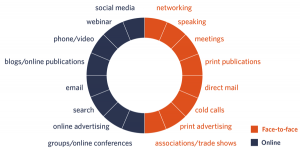
Involuntary churn can have you see up to a 5% loss in monthly billings, generating losses in customers and revenue.
Learn what exactly causes this phenomenon and what you can do to prevent it from occurring.
What Is Involuntary Churn?
Subscription commerce carries with it a greater churn risk because the payment information captured during the first log in transaction is held over the entire duration of the subscription — meaning that with every consecutive renewal, the payment can fail for a series of various reasons.
And, this payment failure risk becomes greater as time passes — so, in essence, the more loyal the customer, the more likely it is that their subscription will be accidentally cancelled. Not good.
This is because, over time, payment information (i.e. credit cards) can become outdated. In such a situation, your loyal customer has been, for example, using your service so long that their payment card has gone expired and, in return, they lose access to their paid account.
Another damaging consequence of involuntary churn is revenue loss. When payment card declines occur, your invoices become past due and if no steps are taken to pay these invoices, (i.e. pay for the subscription), your business ends up losing money.
Worst of all, if the invoice is never paid due to the customer never getting around to updating their payment information, the subscription inevitably churns — meaning that you end up losing all of the revenue you would have gained from this customer in the future.
This kind of churn is labelled “involuntary” because it doesn’t result from the customer’s active will and conscious choice. In fact, it’s highly likely that they didn’t even know that their subscription was at risk of being cancelled.
So, just to recap, involuntary churn occurs when your subscribed customer tries to pay for using your service and their payment doesn’t successfully go through (for reasons we’ll cover in greater detail below) — which consequently leads to a subscription cancellation for your customer and revenue losses for you. A perfect lose-lose scenario.
And, unfortunately, involuntary churn isn’t a marginal problem. In fact, a recent Forrester study shows that it accounts for a whopping 34% of subscriber churn.
This percentage is especially significant given that the damage it causes includes not only revenue losses but also tarnished customer relationships — and the latter is especially difficult to repair.
In fact, if you don’t manage your involuntary churn proactively, it becomes more and more difficult to replace the lost customers you need to grow your business.
What You Can Do to Prevent Involuntary Churn
To choose the right involuntary churn prevention tactics, we must first examine the underlying causes.
Some of the most common reasons for customers involuntarily churning include:
- Soft declines when a credit card has been maxed out
- Hard declines when a card is lost or stolen
- Customers not updating their card information, (i.e. expired cards)
Below, we’ll take a closer look at how to prevent involuntary churn in the abovementioned scenarios.
Card Data Updater
Payment card data can change for a variety of reasons — customers might receive a new card as the result of an upgrade, due to the introduction of new technologies (EMC, chip cards, etc.), or because they lost their card.
Ideally, customers would always remember to update their payment card information — but there’s no use in counting on this actually happening. Especially since studies show that credit card information changes (or lack thereof) are responsible for 40% of transaction failures.
So, even though you should definitely allow customers to update their data on their own via their account, this shouldn’t be the only way to guarantee that you have up-to-date payment information in your system.
We’d also advise against calling your customers, writing them letters, or emails — this is time-consuming and, frankly, quite old fashioned.
The best way to ensure your customers’ payment card date is up-to-date would be to find a payment processor whose merchant account platform is equipped with auto-updates.
A good example of such automation capabilities would be AI-based algorithms. These can automatically update payment card information or enable you to use another one of your customer’s cards to process failed transactions.
Such algorithms, when properly tailored and optimized to your business model, can recover a significant amount of failed transactions and reduce your involuntary churn rate.
If you do find a payment processor with a smart AI-based card data updater, ask them which international cards and carriers they cover, to make sure your most valued customer base will be serviced.
Another means of reducing involuntary churn would be to send your customers automatic notifications when their credit card is about to expire.
Talk to your payment processor as they should be able to set up your system so that it automatically notifies your customers a week or two weeks before their card’s expiration date. This should give them enough time to get things in order.
It’s also in good taste to send your customers a notification, which informs them that their payment failed and asks them to provide an alternate means of payment. If you don’t do this, the risk of involuntary churn will be very high.
Success Rate Monitoring
You can’t optimize something, if you can’t measure it — and you won’t be able to measure it, if you can’t see it. This is where transaction monitoring comes in.
According to Forrester, insufficient funds are responsible for 53% of recurrent payment failure. This seems like a lot but if you have access to data insights gathered through monitoring, you’ll be able to actively counteract this issue.
You’ll be fully aware which transactions have successfully gone through and which haven’t, enabling you to see exactly which of your subscribers isn’t paying their service fees.
This, in turn, will enable you to contact them to let them know what is happening, which will hopefully lead to the situation being resolved.
Find a payment processor who can offer 24/7 monitoring of your payments’ success and failure rate. This will let you learn how many of your payments are declined each day due to avoidable phenomena such as bugs or system issues.
And, with this knowledge in hand, you’ll be able to see exactly where the problem is and how to alleviate it, helping you reduce the number of easily avoidable transaction failures.
Tailored Retry Logic
Even in instances when your customers have set up automatic payments, transactions can still end up being denied. The reason for the failure could be anything from a temporary credit limit to full on network outages.
Thankfully, however, such situations can be resolved with the use of Retry Logic technology, which is able to automatically retry processing failed transactions — giving them a couple of more chances to successfully go through.
However, note that, how you retry failed transactions should differ based on your industry’s specific implications, your business model, and the customer’s chosen payment method.
To most effectively configure the Retry Logic, you should be able to specify the maximum number of consecutive retries that the system should perform as well as the function’s schedule and frequency.
This is important to get right before you start using the Retry Logic function as, for instance, an excessive amount of retries could lead certain credit card networks to issue fraud warnings, resulting in your account being labelled as high risk or put on hold.
Talk to your chosen payment processor about making the appropriate optimizations to your Retry Logic functionality, so that it will be ideally tailored to your business model from the very beginning.
Look for a payment processor whose retry functionality offers:
- Multiple charge attempts — meaning that if a payment fails, it can be automatically retried at specific intervals, which you should be able to define via your merchant account.
- Webhooks used to receive updates — such updates will inform you about any failed payment attempts, allowing you to quickly notify your customers to let them know what is happening.
- Various cards you can charge — ideally, you should be able to input information for more than one of your customers’ cards. This way, if a payment the customer made using one of them fails, you’ll be able to charge another one of their cards.
- Notifications sent to customers — this feature will allow your customers to find out when one of their transactions fails, or if there’s a problem with their subscription fees. Over time, this will lead to a high customer lifetime value and an uninterrupted revenue stream.
- Immediate insights — it’s crucial to have access to real-time transaction monitoring, as this will enable you to react to failed transactions instantly.
Renewal Notifications
As a merchant running a subscription-based business you have to continuously win your customers over. In an era where novelty and jumping from one trend to the next is basically a way of life, you have to make them want to keep coming back to you — to your same ol’ service.
That’s tough in and of itself, so make sure to use the subscription renewal process as an opportunity to check in with your customers and remind them why sticking with you is the right choice.
To do this, take note to make the renewal process as easy, informative, and seamless as possible.
For instance, when customers have already given you the necessary authorizations to renew their subscription automatically, it’d be a good idea to send them a notification each time you charge their credit card.
Such a notification should confirm the renewal of their subscription and let them know that the recent payment on their card is one which covers fees associated with this.
However, if your customer didn’t select “auto-renew”, thereby also not giving you the right to automatically charge them, you have to notify them about the upcoming subscription renewal date so that they can make the necessary payment on time.
Terminating someone’s access to your service without giving them a heads up is seriously bad for business. If you do this, it’s quite likely that you will lose this customer to involuntary churn — forever.
Everyone’s busy, so please don’t expect your customers to remember the exact date they should renew their subscription — that’s on you.
Thankfully, some providers will give you access to the renewal notification feature, which is great at helping customers (who opted out of the “auto-renew” option) make their renewal payments before the subscription’s end date.
Additionally, such notifications could be sent with customizable messages that inform your customers that they can make changes to their subscription at any time, i.e. that they can still choose the “auto-renew” option. Just make sure to give them about a week or two notice so they can react in a timely manner.
Using a Single Payment Platform
Forrester’s study found that 96% of professionals responsible for their company’s subscriptions and recurring payments agree that using a single platform would “significantly” or “somewhat” improve their ability to reduce involuntary churn.
As a merchant whose business model is largely based on recurring payments, it’s best to ensure that these are processed quickly and seamlessly.
To be able to take advantage of the best possible recurring payments model, you should choose a merchant account services provider who has extensive experience in payment processing as well as, ideally, knows the ins and outs of your business model and industry.
By working with a single trusted payment processor, you’ll be able to take advantage of:
- A lower involuntary churn rate
- A higher payments’ success rate
- A better customer lifetime value
Moreover, partnering with a single provider will make it easier to optimize recurring payment processes, as they’ll be able to really get to know your business model and specific needs.
Talk to your shortlisted providers and check which of them offers 1-click payments for all your recurring transactions and returning customers. These are great at keeping your clientele coming back for more and your revenue streaming.
Moreover, 1-click payments are especially effective at boosting conversion if your business operates in the online gaming, entertainment, or dating industry. This is because they enable customers to make quick and seamless transactions in mere seconds — as they don’t have to fill in their credit card details every time they want to make a purchase.
And, if you’re looking to go above and beyond in terms of transactional security, check whether your chosen provider covers customers’ personal information with tokenization technology. If they do, you can rest assured that everything will be securely encrypted.
The Takeaway
Churn — it’s undeniably responsible for revenue leakage. But it also has a detrimental effect on innovation and product development. As such, a high involuntary churn rate can leave many business owners feeling as though they’re not in control of their operations.
And the time spent trying to chase failed payments with all of the different payment processing partners you’re working with can stand in the way of your company’s ability to keep up with market trends — leaving you vulnerable to being left behind.
That’s why it’s important to commit to reducing involuntary churn as part of your ongoing risk prevention and business growth strategy.
Since a staggering 96% of professionals surveyed by Forrester agreed that having a single payment platform would help reduce their company’s involuntary churn rate, consider partnering up with a single provider who will be able to cover all of your payment processing needs.
Having just one provider would also ensure that if any issues arise, you’d have a single dedicated technical support team and wouldn’t have to waste time contacting various different providers to find out why certain payments didn’t go through.
Business & Finance Articles on Business 2 Community
(48)








